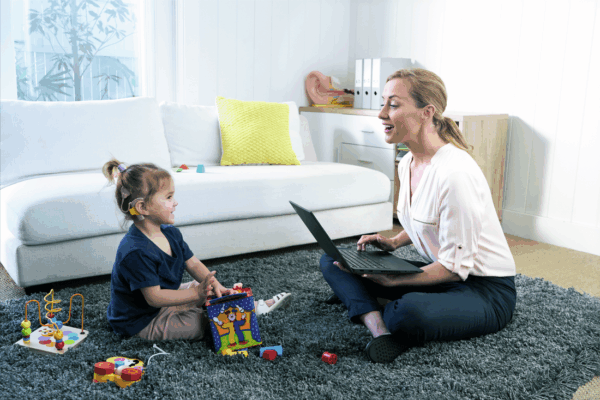After waiting and wondering what your child’s life will be like with a cochlear implant, it’s now happening! You may have had high expectations about what your child will be able to hear. You might have been worried if they will hear at all. Here are tips to help your child hear their best. One of the most important tips is to make sure your child wears their sound processor every day and most importantly, all day.
“The best advice to give is to wear the sound processor during waking hours. Research shows people experience the best outcomes when they wear their sound processor a minimum of 10 hours a day,” 12
– Jen, Clinical Audiologist at Cochlear.
Why is it so important?
Consistent wearing of the sound processor is one of the keys to unlocking the full potential of your child’s hearing experience.
This is because your child’s brain needs to adapt to new sounds. This doesn’t happen overnight, it takes time. Wearing the sound processor for long periods of time allows your child’s brain to adapt more quickly to processing sounds through their implant.
Longer periods of wearing the device help to improve hearing performance outcomes,345 so wearing their processor and keeping it on is critical in achieving this goal.
Parent tip 1
“The best way I found to get him to wear it is to give him really positive experiences with it from the get-go and giving him a nice treat if he keeps it on for longer periods. Another technique is creating a story about how cool the sound processor is, showing him his X-ray of the cochlear implant, and encouraging him to show it off to friends.”
– Roxi, parent of Christian, who has a cochlear implant
Understanding “listening fatigue”
It’s also important as a parent to understand that your child will likely feel tired more than usual after concentrating on listening. They may also feel frustrated from all the new sounds. This is called “listening fatigue”, which we’ll cover in this series.
Encourage your child to take short breaks to relax and take a rest from intensive listening whenever you can. Stepping away and tuning out from sounds for a short period of time will also help to reduce overstimulation.
Remember, the goal is to wear the sound processor for as long as your child can. If taking a five-minute break helps them wear it for another two hours, encourage that (with the goal of building up their tolerance).
Parent tip 2
“I ensure he has enough breaks without chastising him for it, and I remind him that his brain needs time to learn to adjust to the sound processor. And that’s going to happen only if he actually wears it consistently and practices listening with dedicated attention.
– Roxi
Despite good intentions, encouraging your child to wear their device constantly can be a real challenge—especially since they’re not used to the device. Some children pull the processor off and may risk losing it during playtime.
Two things you can try:
1. Make it fun for your child to wear the sound processor.
2. Use retention devices for peace of mind.
Cochlear offers multiple retention options to help keep the sound processor in place and secure, especially during physical activities and sports. You can find these in the online Cochlear Store.
A guide to retention options
1. Snugfit: helps tighten the sound processor on the ear, especially for active adults and children. The Snugfit comes in three convenient sizes: small, medium and large.
2. Koala Clip: clip-on retention device designed for babies and younger children.
3. Safety Cord: provides a convenient way to ensure your child’s sound processor doesn’t get lost if it comes off their ear.
4. Safety Lines and Safety Line Hair Clips: great option to provide extra security for your child’s sound processor.
5. Earhook: comfortably secures the sound processor to your child’s ear. Young children may want to try the small size earhook for comfort.
6. Hugfit™: helps secure the sound processor on even the smallest of ears with a soft, flexible tube.
7. Headband: an optional accessory that holds the sound processor in place.
8. Cochlear™ Earmould Adaptor: allows you to attach a custom earmold to your child’s Cochlear™ Nucleus® 8 Nexa™ Sound Processor as an option for those who are comfortable using an earmold, such as former hearing aid users. (Note: the custom earmold is not supplied by Cochlear. Follow up with your clinician about this option.)
Visit the online Cochlear Store to view retention devices and keep your device in place.
- Lindquist NR et al. Early datalogging predicts CI performance: building a recommendation for daily device usage. Otology & Neurotology 2023;44(7): e479–e485.
- Holder JT et al. Effect of increased daily implant use on auditory perception in adults. J Speech Lang Hear Res 2021;64(10):4044–4055.
- Easwar V et al. Impact of consistency in daily device use on speech perception abilities in children with cochlear implants: datalogging evidence. Journal of the American Academy of Audiology 2018;29(09):835-46.
- Wiseman KB et al. Relationships between daily device use and early communication outcomes in young children with cochlear implants. Ear and Hearing 2021;42(4):1042-53.
- Gagnon EB et al. The impact of cumulative cochlear implant wear time on spoken language outcomes at age 3 years. Journal of Speech, Language, and Hearing Research 2021;64(4):1369-1375.

